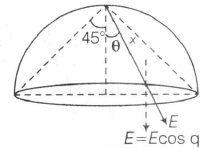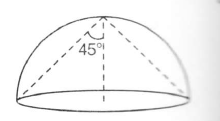Answer:
Option A,D
Explanation:
Ω = $2\pi(1-\cos\theta):\theta=$45°
$\phi =\frac{Ω}{4\pi}\times \frac{Q}{\epsilon_{0}}=-\frac{2\pi(1-\cos\theta)}{4\pi}\frac{Q}{\epsilon_{0}}$
= $=-\frac{Q}{2\epsilon_{0}}(1-\frac{1}{\sqrt{2}})$
(b)
The component of the electric field perpendicular to the flat surface will decrease so we move away from the centre as the distance increases.
(magnitude of electric field decreases) as well as the angle between the normal and electric field will increase. Hence, the component of the electric field normal to the flat surface is not constant.
ALTERNATE SOLUTION
$x=\frac{R}{cos\theta}$
$E=\frac{KQ}{x^{2}}=\frac{KQ\cos^{2}\theta}{R^{2}}$
$\Rightarrow$ $E_{\perp}=\frac{KQ\cos^{3}\theta}{R^{2}}$

As we move away from centre
$\theta\uparrow\cos\theta\downarrow so E_{\perp}\downarrow$
(c) Total flux Φ due to the charge Q is $\frac{Q}{\epsilon_{0}}$

So, Φ through the curved and flux will be less than $\frac{Q}{\epsilon_{0}}$
(d) Since, the circumference is equidistant from Q it will be equipotential $V= \frac{KQ}{\sqrt{2}R}$